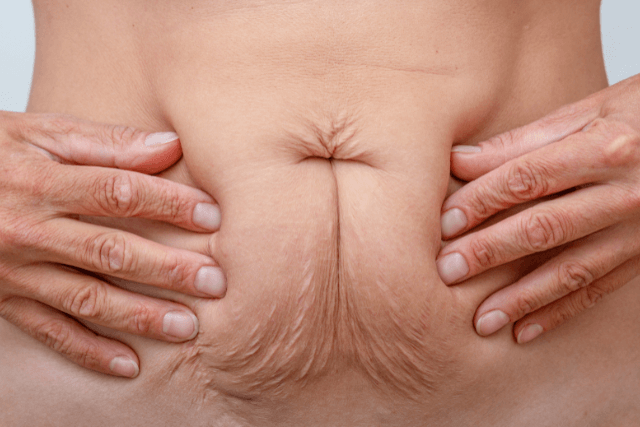Reduce Breast Surgery Overview
This comprehensive reduce breast surgery guide addresses all the questions or concerns of individuals considering breast reduction surgery. While ensuring that detailed FAQs are well-organized. As well as easy to understand.
Breast reduction surgery (reduction mammoplasty) is a big operation to get rid of physical discomfort and improve life for those with too big breasts. This guide covers everything you need to know about breast reduction scars from the basics to the advanced stuff, with a focus on facts and helpful info.
What is Breast Reduction Surgery?
Breast reduction surgery (reduction mammoplasty) is the removal of excess breast tissue, fat, and skin to get a breast size that’s proportional to the body. This surgery can get rid of the discomfort of too big very large breasts and, back, neck, and shoulder pain.
According to the American Society of Plastic Surgeons (ASPS), it’s a popular procedure, over 100,000 women in the US have this procedure every year.
What is a Reduction in Surgery?
In surgical terms “reduction” means to decrease the size of an anatomical structure. In this case, the breasts. Reduction mammoplasty reduces breast size while trying to maintain a natural look and feel.
How Does Reduction Surgery Work?
The surgery involves making incisions on the breasts, removing excess tissue, fat, and skin, and re-shaping the remaining tissue to create smaller, uplifted breasts. The nipples and areolas are often repositioned to a more natural position on the chest. The details of certain complications of the surgery vary depending on the patient and the surgeon.
Types of Breast Reduction Techniques
There are various techniques used in breast reduction surgery, depending on the individual patient:
Anchor or Inverted-T Incision
The most common technique especially for big reductions involves three incisions: around the nipple and areola together, vertically from the bottom of the areola to the breast crease, and horizontally along the breast crease.
Vertical or Lollipop Incision
This technique involves fewer incisions is suitable for moderate reductions and results in less scarring.
Donut or Periareolar Incision
Involves a single incision around the areola, used for minor reductions or lifts.
Liposuction-only Reduction
For those with minimal excess skin and good skin elasticity, liposuction alone can reduce breast size by removing excess fat only.
What is a Full Breast Removal Called to Remove Excess Breast Tissue?
Surgeons also refer to a full breast removal as a reduction mammoplasty or a mastectomy. Furthermore, mastectomy is usually for medical reasons such as breast cancer and involves removing almost all breast tissue.
What Happens in a Mammoplasty?
A mammoplasty is any surgical procedure that changes the shape or size of the breasts. Reduction mammoplasty reduces the breast size and other types of plastic surgery like augmentation mammoplasty increase the breast size.
Is Mammoplasty the Same as Breast Reduction?
Yes, mammoplasty can refer to breast reduction when it involves reducing breast size. But mammoplasty encompasses all types of breast surgeries including augmentation and lift procedures.
Before You Get Breast Reduction Surgery
Before you get breast reduction surgery you should know:
- Consult with a board-certified plastic surgeon about your goals, medical history, and expectations. They will evaluate you and recommend the best technique.
- As with any surgery, breast reduction has risks like infection, scarring, and changes in nipple sensation.
- Many insurance companies cover breast reduction if it’s medically necessary. You may need to document symptoms like chronic pain or rashes to get coverage.

Reduce Breast Surgery – Eligibility and Criteria
To determine if you’re a candidate for breast reduction:
How Big Do Your Breasts Have to Be to Get a Reduction?
There is no specific size requirement but women with breasts that cause physical discomfort or emotional distress are top candidates. Generally, women with a D cup or larger are considered for cosmetic surgery only.
What Size Qualifies for Breast Reduction?
The size that qualifies for reduction varies. If your breasts are causing physical or psychological issues you likely qualify. Besides this, the insurance companies use specific criteria. Such as the amount of tissue to be and how much breast tissue is removed to determine coverage.
What Breast Size is Considered for Reduction?
Large breasts that interfere with daily life. Whether due to physical discomfort or self-esteem issues. Typically considered for breast reduction surgery. Additionally, the size of your breasts alone isn’t the only factor. But also the impact on your quality of life is critical.
What Factors Determine Whether You Are a Good Candidate for Breast Reduction Surgery?
Key factors include:
Physical Symptoms
Chronic back, neck, or shoulder pain, and skin irritations are strong indicators.
Emotional Distress
If large breasts negatively affect your self-esteem or mental health, surgery might be a good option.
Breast Composition
The ratio of glandular tissue to fat in your breasts will influence surgical technique.
How Big Do Your Breasts Have to Be for Reduction Surgery?
There’s no universal answer, but if your breast size causes chronic pain, posture issues, or hinders physical activities, you may be a candidate for surgery.
Can Any Breast Size Get a Reduction?
Technically, any breast size can be reduced, but the surgery is generally recommended for those with larger breasts that cause significant problems. Smaller breast reductions are possible but might not be covered by insurance.
What Disqualifies You from a Breast Reduction?
Certain factors may disqualify you from surgery, such as poor overall health, smoking, or unrealistic expectations. Significant weight fluctuations can also affect the outcome, so a stable weight is important.
Are There Specific Health Criteria for Breast Reduction Eligibility?
Yes, good health is crucial. Patients should be non-smokers, free from serious medical conditions, and at a stable weight. Those with diabetes or heart conditions may need additional evaluations before surgery.

Reduce Breast Surgery – Procedures and Techniques
Understanding the various surgical procedures helps you make an informed decision.
Which Surgery is Best for Breast Reduction?
The best surgery depends on your specific needs. For significant reductions, the anchor or inverted-T incision is often preferred. For moderate reductions, the vertical incision may be sufficient.
Does a Breast Reduction Include a Lift?
Yes, breast reduction typically includes a lift. As excess tissue is removed, the remaining breast tissue is reshaped and lifted to a higher position on the chest.
Do Breasts Look Better After Reduction?
Most patients find that their breasts look better—smaller, more proportionate, and lifted. Scarring is a consideration, but it usually fades over time.
Does a Bilateral Breast Reduction Include a Lift?
A bilateral breast reduction procedure, which involves reducing both breasts, usually includes a lift as part of the reshaping process. This ensures that the breasts are symmetrical and aesthetically pleasing.
How is a Bilateral Breast Reduction Done?
A bilateral breast reduction is done just like a regular reduction but on both breasts. The surgeon removes tissue and skin from one or both breasts and reshapes them to achieve symmetry and the desired size.
What are the Steps of Breast Reduction?
- Anesthesia – The patient is put to sleep.
- Incision – The surgeon makes the incision based on the technique used.
- Tissue Removal – Excess breast tissue, fat, and skin is removed.
- Reshaping – Remaining tissue is reshaped and nipples are repositioned.
- Closure – Incisions are closed with sutures and bandages are applied.
What is the Difference Between a Breast Reduction and a Breast Lift?
A breast reduction reduces the size of the breast, and a breast lift (mastopexy) lifts the sagging breast without changing the size. Many will perform breast reductions that include a lift.
Are there Non-Surgical Options for Breast Reduction?
Nonsurgical options like weight loss, exercise, and hormone therapy can reduce breast size slightly but are not as effective or targeted as surgery.

Reduce Breast Surgery – Costs and Fees
Breast reduction surgery can be expensive but varies.
How Much Does it Cost to Reduce Your Breast Size?
In the United States, the cost ranges from $6,000 to $12,000. This includes surgeon fees, anesthesia, and facility costs. Geographic location and surgeon experience also play roles in the overall price.
How Much Does it Cost to Have One Breast Removed?
The cost to remove one breast, often due to medical reasons like breast cancer itself, can range from $7,000 to $15,000. This includes mastectomy and reconstruction if chosen.
What is the Average Cost of a Breast Reduction?
The average cost is about $8,000. But can vary widely depending on the complexity of the surgery and the region where the surgeon performs the surgery.
How Much Does a Bilateral Breast Reduction Cost?
A bilateral breast reduction generally costs the same as a standard reduction, ranging from $6,000 to $12,000. Some health insurance plans may cover the procedure if it’s medically necessary.
Are There Financing Options Available for Breast Reduction Surgery?
Yes, many plastic surgeons offer financing plans, and there are also medical credit companies that provide loans specifically for some cosmetic plastic surgery procedures.
Does Insurance Cover Breast Reduction Surgery?
Insurance often covers breast reduction surgery if it’s deemed medically necessary. This usually requires documentation of symptoms like chronic breast pain, or skin conditions caused by overly large breasts. However, coverage criteria vary by insurer, so it’s important to check your specific plan.

Reduce Breast Surgery – Recovery and Aftercare
Understanding the recovery process is crucial for a successful outcome.
How Long Does a Breast Reduction Last?
The results of breast reduction are typically permanent, although factors like weight changes, pregnancy, and aging can affect breast size over time.
What is the Recovery Time for a Bilateral Breast Reduction?
Recovery usually takes about 6 to 8 weeks. Most patients can return to work and normal activities after about 2 weeks. Nonetheless, surgeons recommend avoiding strenuous exercise for at least 6 weeks.
How Long Does it Take to Recover from a Breast Reduction?
Full recovery can take several months, but most patients feel significantly better after the first few weeks. Scars will continue to fade over time.
What Happens to Your Body After a Breast Reduction?
After a breast reduction, you’ll lose weight and likely experience relief from physical symptoms like back and neck pain. Your posture may improve, and many patients report feeling more confident and comfortable in their bodies.
How Painful is Breast Reduction?
Pain levels vary, but most patients experience mild to moderate discomfort, which is manageable with prescribed pain medications. The first few days are usually the most uncomfortable, but the pain decreases significantly after that.
What Are the Chances of Complications from Breast Reduction Surgery?
While complications are rare, they can include infection, scarring, loss of nipple sensation, or asymmetry. Choosing a skilled surgeon can minimize these risks.
How Painful is a Boob Reduction Surgery?
The surgery itself isn’t painful due to the general anesthesia used, but post-operative pain is common. However, surgeons generally control pain with medication. That eventually tends to subside within a week or two.
What Should You Expect During the Breast Reduction Recovery Process?
During recovery, you’ll need to wear a surgical bra, avoid strenuous activities, and keep the incision sites clean and dry. Swelling and bruising are normal but will subside over time.
Are There Specific Aftercare Instructions to Follow Post-Surgery?
Yes, follow up visit to your surgeon’s instructions closely, which will likely include:
- Wearing a support bra without an underwire for several weeks.
- Keeping the incisions clean and dry.
- Avoiding heavy lifting and strenuous exercise for several weeks.
- Attending follow-up appointments to monitor healing.

Reduce Breast Surgery – Risks, Benefits, and Considerations
Understanding the risks and benefits is essential for all your concerns and making an informed decision.
How Serious is Breast Reduction Surgery?
Breast reduction is a major surgery with significant benefits but also carries risks. It’s important to weigh the potential benefits against the risks and to discuss these thoroughly with your surgeon.
What is the Downside of Breast Reduction?
The main downsides are scarring, the risk of complications, and the possibility of not being able to breastfeed in the future. However, many find these risks acceptable compared to the benefits.
What Do I Wish I Knew Before Getting a Breast Reduction?
Many patients wish they had known about the extensive recovery period and the importance of choosing a highly qualified surgeon. It’s also important to have realistic expectations about scarring and the final breast shape.
What Are the Risks of Breast Reduction Surgery?
Risks include infection, scarring skin irritation, loss of nipple sensation, asymmetry, and in rare cases, complications from anesthesia. It’s crucial to discuss these with your surgeon.
What Are the Potential Complications of Breast Reduction Surgery?
Potential complications include:
Infection
Rare but possible, usually manageable with antibiotics.
Scarring
Permanent but typically fades over time.
Nipple Sensation Loss
Can be temporary or permanent.
Asymmetry
Minor differences in breast size or shape can occur.
Can Breast Size Be Reduced Naturally?
Natural methods like weight loss and exercise can reduce breast size to some extent, but they are not as effective or predictable as surgery.

What Causes Breast Size to Decrease?
Breast size can naturally decrease due to:
Aging
Hormonal changes can cause breasts to shrink.
Weight Loss
Reducing overall body fat can decrease breast size.
Hormonal Changes
Fluctuations, especially during menopause, can reduce breast size.
What Are the Long-Term Effects of Breast Reduction Surgery?
Long-term effects are generally positive, with most patients experiencing relief from physical discomfort and improved self-esteem. Scarring is the most common long-term issue, but it usually fades over time.
How Does Breast Reduction Impact Overall Health and Body Image?
Breast reduction often leads to significant improvements in overall health, including better posture and reduced pain. Many patients also report enhanced body image and more self-confidence.
Is Breast Reduction Surgery Right for You?
Breast reduction surgery can be a life-changing procedure for those who struggle with the physical and emotional challenges of large breasts. By carefully considering the benefits, risks, and recovery involved, you can make an informed decision. Always consult with a board-certified plastic surgeon to discuss your specific needs and to ensure you’re making the best choice for your health and well-being.





